There are thousands of ABC books out there. So you’ll need a few good filters to narrow down the options. If your goal is to help teach your preschooler the letters of the alphabet (as opposed to vocabulary, say), use the following five questions to evaluate books:
- Are the target letters legible and set apart by size, color, or font?
- Do they use the most common sounds for each letter?
- Do the illustrations complement (not overwhelm) the letters?
- Is the text kept to a minimum?
- Is the story and vocabulary engaging and understandable for a preschooler or your particular child?
Please note: All of my criteria are for assessing printed alphabet books, which I recommend highly over ebooks for letter learning. Although digital books, including ABC books with interactive elements, are growing in popularity, early research suggests that printed books are more engaging for three- and four-year-old kids. There’s something about holding printed books in hand that gets three and four year olds more jazzed about naming and touching letters than ebooks do.
Look for letters that are easily legible and set apart by size, color, or font
When teaching letters is your aim, it should go without saying that the alphabet books you choose should feature crisp, clear letters. But this point is often overlooked by book buyers. We get sold on the novelty, cleverness, or artistry of certain ABC books’ content or illustrations, forgetting our preschool audience and our goal of teaching letters.
In terms of what does work for alphabet books, a wide range of fonts will do. The typography or text characters just need to clearly distinguish the lines, curves, humps and dots of the letters they feature.
I recommend that parents start with books that focus on uppercase, print letters first. This eliminates the challenge of tackling the intricacies of the hooks and curves that turn up in many fonts’ portrayals of lowercase “a” and “g.” (See this great video on the elusive letter G.)
Once kids have mastered the uppercase letters, then you can shift attention to the lowercase versions and even feel free to throw script and handwritten fonts into the mix. Most alphabet books that feature uppercase letters also include examples of lowercase letters on their pages, so you’ll have both bases covered.
Many books that make lovely additions to more advanced readers’ libraries don’t pass the eyeball test for beginning letter learning. In AlphaBit, for example, the color gradients, jagged edges, and inner dots muddle the letter shapes. Its target audience is likely a more advanced reader with an appreciation for classic video games. Think young gamers with the skills to navigate pixelated seek-and-find quests and more advanced vocabulary on the page.
And in A to Z Menagerie, the illustrations are the main act. The tiny object labels are mere afterthoughts, written in such a light, faint font that you can’t trace the letters’ contours or highlight their curves and intersections for beginning readers. This title is more suited to building oral language and knowledge of letter sounds than for teaching kids to recognize print letters.
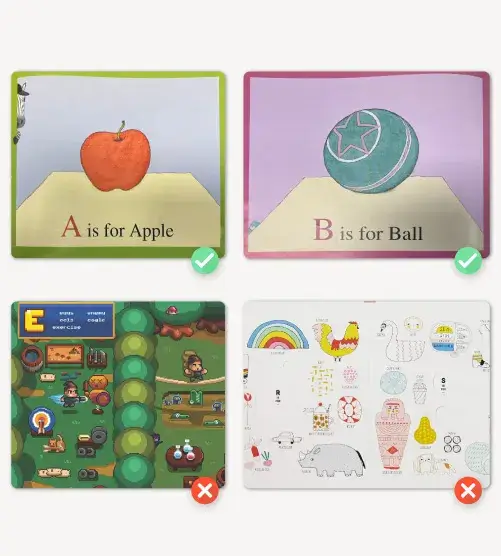
Seek out ABC books that use the most common letter sounds
To help beginning readers start to make letter-sound connections, it’s best to focus on introducing them to the highest-frequency sound(s) for each letter. For example, the /g/ sound for G (go), not the /j/ sound (gesture).
But alphabet books tend to be all over the map with the words they use to represent sounds. Some, like P is for Pterodactyl: The WORST Alphabet Book Ever (their words, not mine), delight in presenting rare sounds for each letter. Use a title like this to build spelling skills down the line, not for teaching preschoolers their ABCs.
Similarly, A is for Bee: An Alphabet Book in Translation, offers a beautiful and inventive exploration of variations in languages across cultures and subverts the “A-is-for” formula to serve up matches in other languages. This would be a book to buy if your aim was sparking lovely conversations about vocabulary with the little linguists in your life. It’s not a fruitful starting point for teaching English letter-sound basics, though.
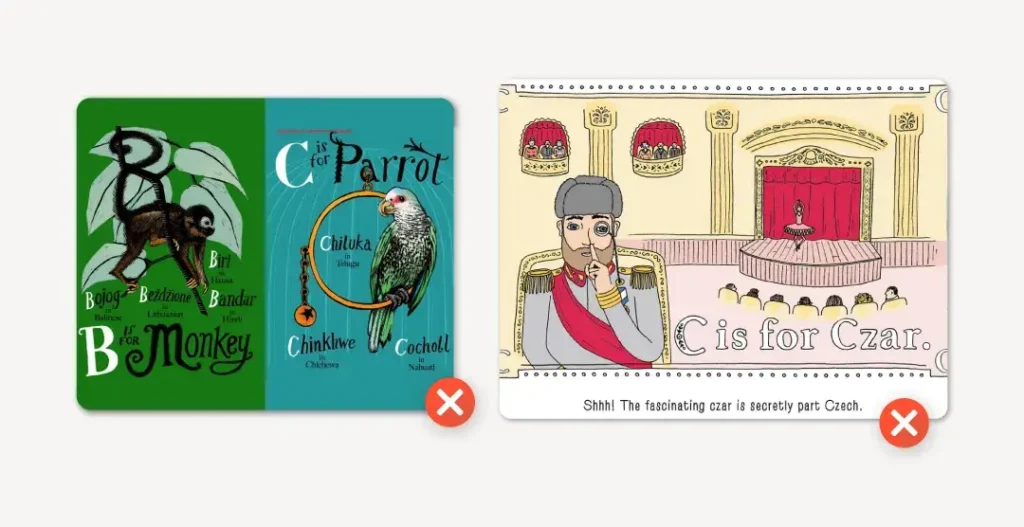
When browsing ABC books, you may want to use Jessica Toste’s sound chart, shown below, to check which use the highest-frequency sound for each letter. Keep in mind that for the letter X, the best examples will fall at the ends of words: Fox and box better illustrate the main /ks/ sound of the letter x than xylophone, an ABC book favorite that actually features the /z/ sound. That said, few alphabet books feature the most common sound for every single letter, so my rule of thumb is to go with books where at least 20 examples do, or (preferably) even more.
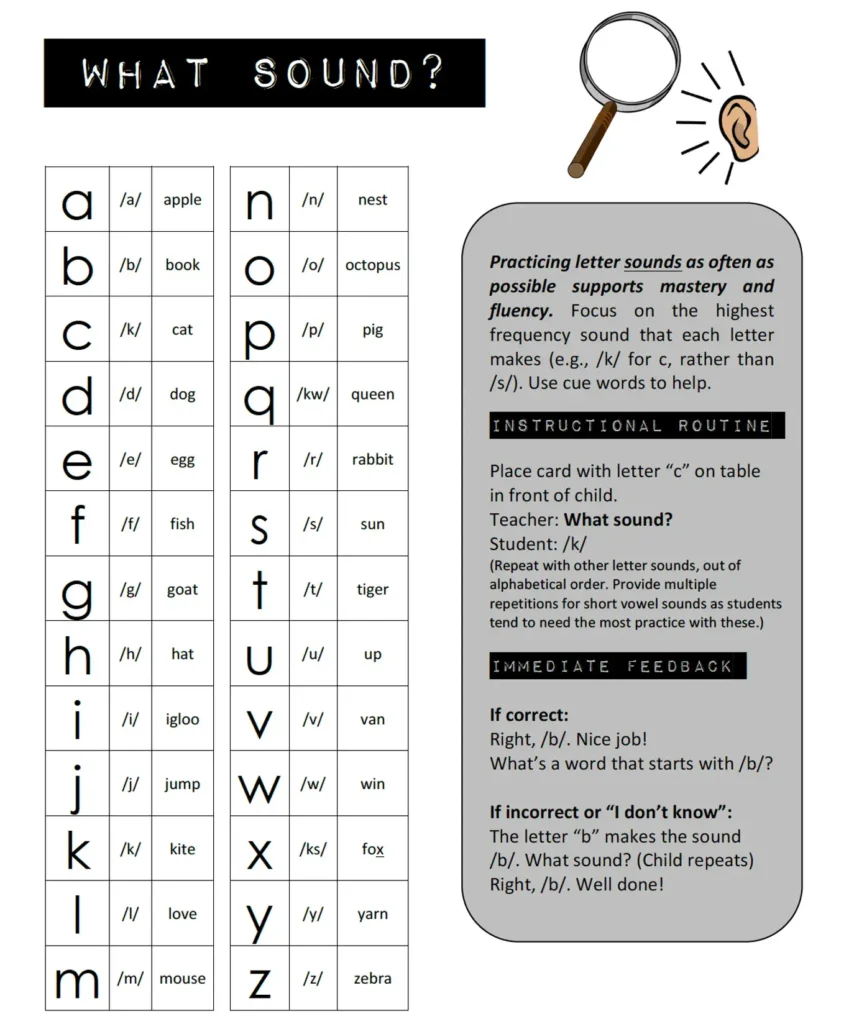
Make sure the illustrations don’t overwhelm the letters
The classic letter-is-for-object format (e.g., A is for apple) can present a bit of a riddle for kids to solve. If the puzzle is too complex, the learning can take a hit. For example, an illustration of D is for dog might also show a yard, ball, stick and any number of other objects in addition to a dog. This means the child trying to understand the words will need to figure out which is the target item. When the illustration is too complex or is open to multiple interpretations, it makes the lesson harder to grasp.
So simpler illustrations are better for alphabet teaching. You want your little one to tune into the letter shapes, names, and sounds, not get lost in the imagery or mystery of the sound-object match. Q is for queen paired with an image of a woman in a crown is more helpful than hard-to-interpret scenes meant to illustrate abstract words like question, quirky, or quality.
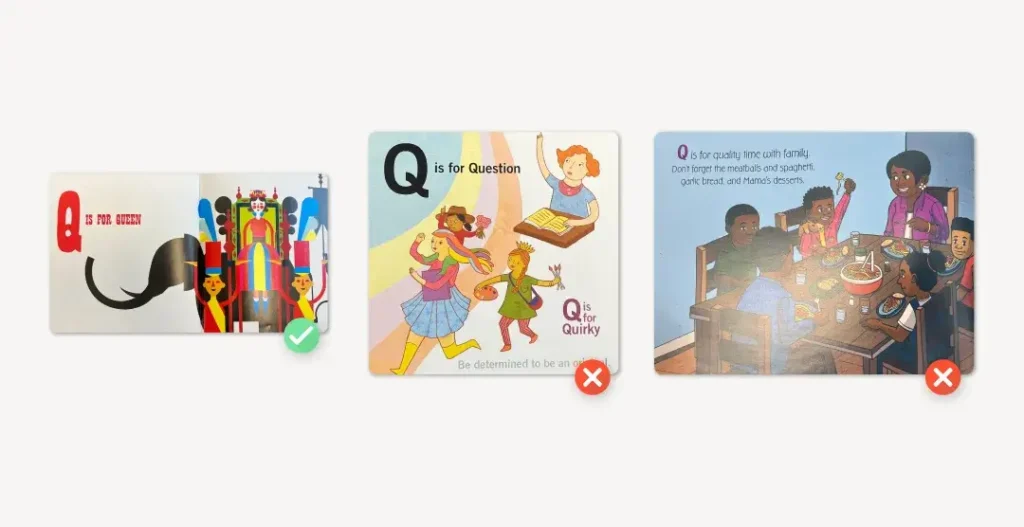
Additionally, some of the books with the most compelling illustrations also have the least-clear letter shapes. At least eight different alphabet books have won Caldecott medals or honors, which are given to the artists of exceptional picture books, but art (not letters) are their focus. The result: imaginative but less recognizable letter forms. These volumes are better suited to engage more advanced learners than for teaching preschoolers the alphabet.
Caldecott Honor winner Alphabatics is an exception. Lauded for its illustrations, it also features bold sans serif upper and lowercase letters that draw kids’ attention to the letter shapes.
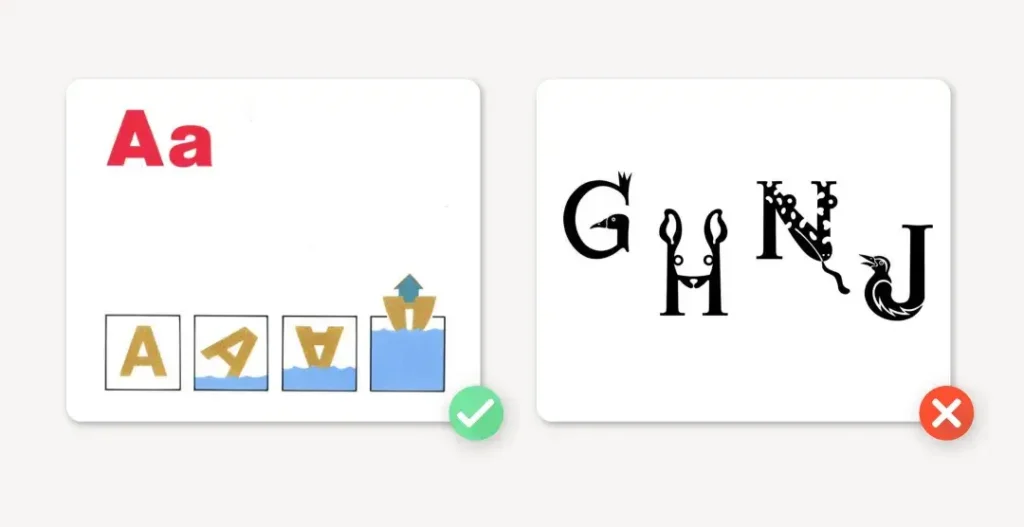
Look for ABC books that don’t have too much text
And it’s not only illustrations that can clutter and distract from letters on the page. Too much text is a drag on little ones’ attention, too. In the face of text overload, studies suggest that kids start paying more attention to the illustrations.
Moreover, a small study that compared how middle-income parents read a “busy” and a “less busy” alphabet book to kids found that the density of text and images affected how parents spoke with kids. The “less busy” book featured fewer words and sentences per page, more monochromatic images, and a larger target letter printed in a contrasting color. This format led the parents to talk about the print in a way they didn’t with the busier book.
One caveat is that most ABC books have more text and images than are ideal for letter-teaching purposes, so it may take some time to find your favorites. Still, titles with simple text like B is for Baby by Atinuke are out there.

Check that the book and vocabulary will make sense to your child
There’s a lot more going on in reading an ABC book than flipping through a stack of letter flashcards—happily. So it’s also important to consider the story and vocabulary in an ABC book, as well as the background knowledge and context necessary to understand it.
Aim to select books that make sense to kids on both the word and story levels. If the vocabulary is too much of a stretch in terms of meaning and pronunciation, it only distracts from the core mission of teaching letters. Lighten the cognitive load by choosing books full of words your child is likely to already understand or can quickly grasp, plus storylines or examples they care about.
A common misstep parents make is buying alphabet books on themes that interest us, not our kids. Sure, they’ll get something out of the shared reading experience of nearly any book, but why not put your child first when you choose a book for them?
U is for Unicorn: The ABCs of Silicon Valley is hilarious, but I would give it to an older child, even a middle or high schooler, as a way to build vocabulary and topic knowledge.
Emergent readers will get more out of titles about the horned variety of unicorn than the elusive billion-dollar-valuation startup. And while incubator starts with the common /i/ sound, it’s a bit advanced for the preschool set.
Even alphabet books designed with kids in mind can lead us astray from letter learning by introducing less-common letter sounds or a variety of distracting fonts. Alphabet books that explore historical figures, local habitats, folklore, and more are wonderful when you want to build your child’s knowledge of different topics, bolster their vocabulary, and deepen their spelling knowledge—not for teaching them their letters early on. In fact, I’d venture to say that most alphabet books are best suited for exploring topics other than the alphabet. The intricate illustrations and advanced vocabulary just aren’t designed to help beginning readers lock in on print.

May these five questions help you home in on titles that will actually help build the letter knowledge your child needs.
If you found this post helpful, please share it!

